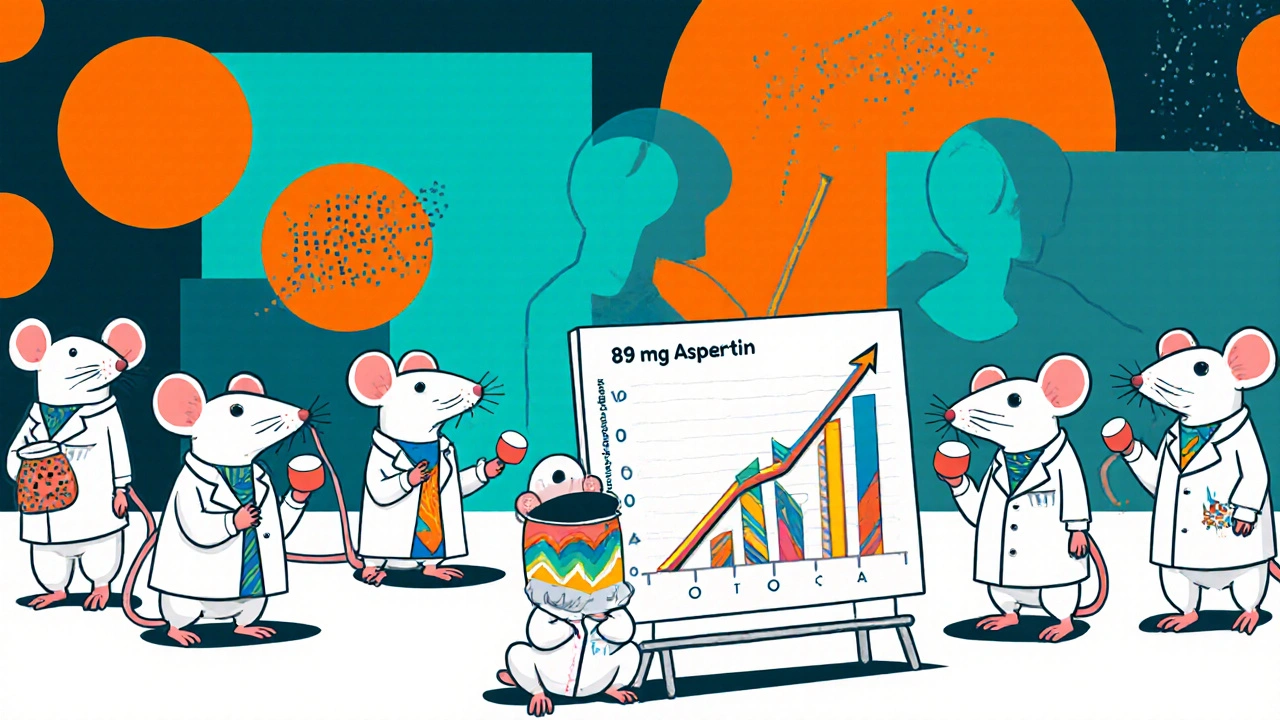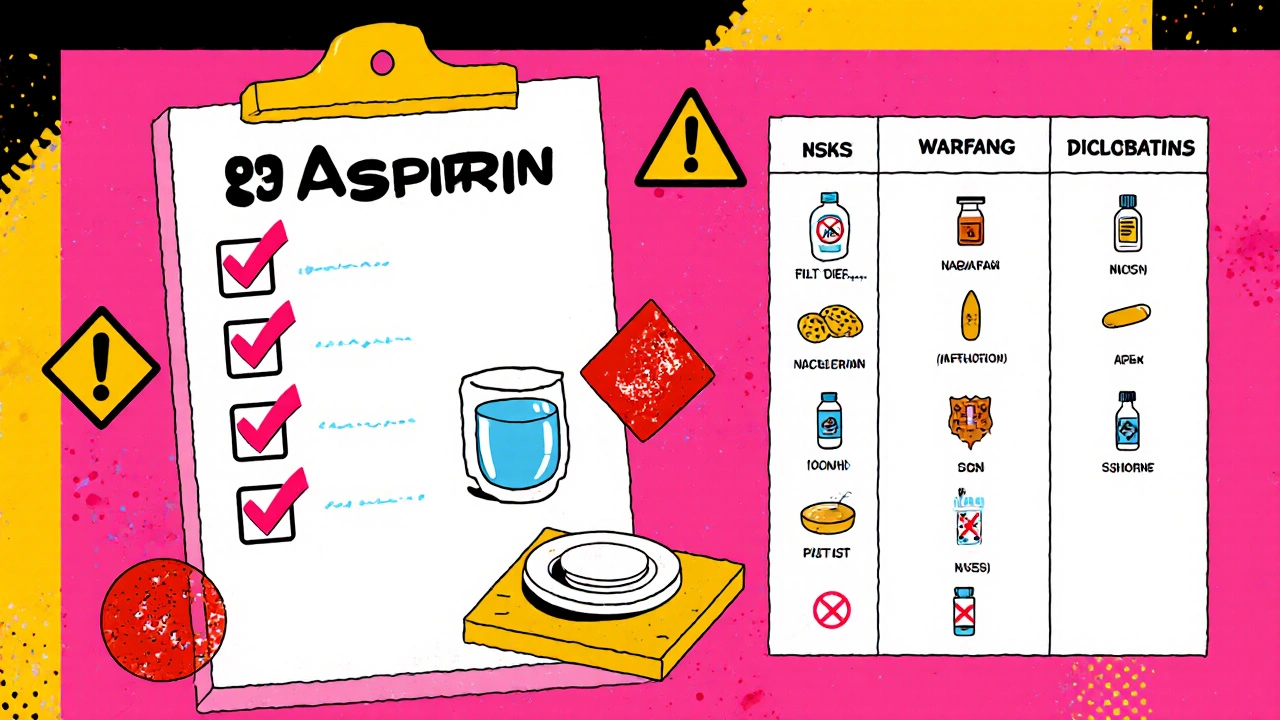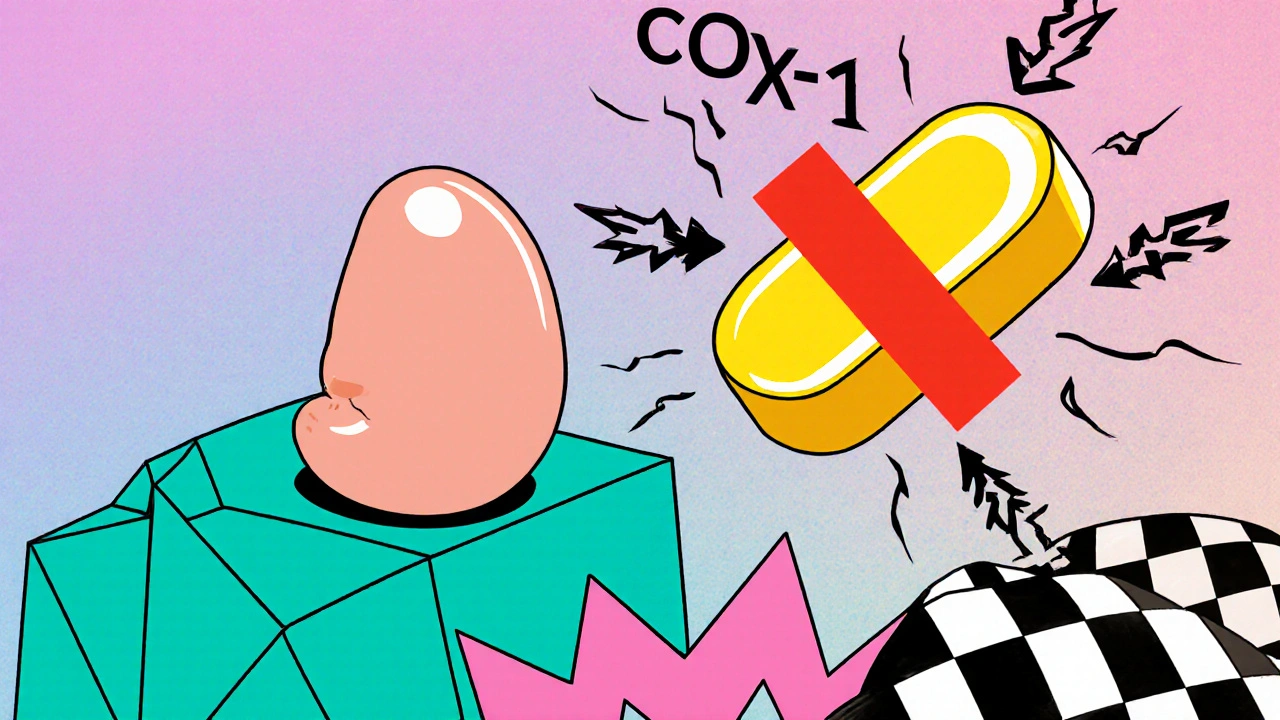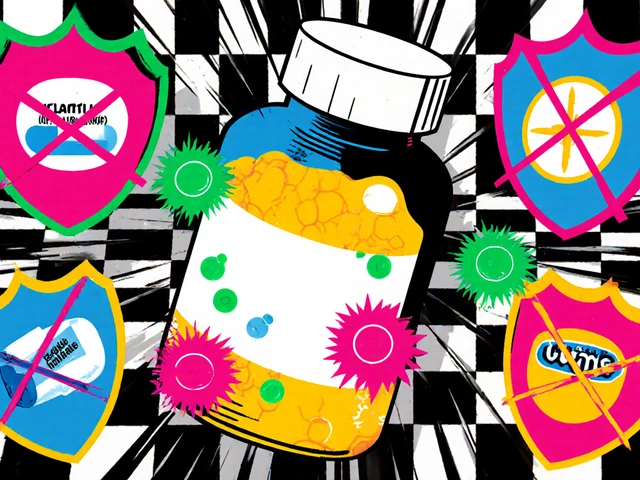Key Takeaways
- Aspirin’s anti‑inflammatory action can influence pituitary hormone release.
- Animal studies show reduced prolactin and growth hormone spikes after low‑dose aspirin.
- Human data are limited; benefits must be weighed against bleeding risk.
- Low‑dose (81 mg) daily is generally safer for long‑term use than higher doses.
- Consult a doctor before adding aspirin if you have hormone‑related disorders.
When we talk about aspirin is a pain‑relieving, anti‑inflammatory drug classified as a non‑steroidal anti‑inflammatory drug (NSAID), the focus is often on heart health or headache relief. Yet a growing body of research hints that this humble tablet might also affect the tiny master gland perched at the base of the brain - the pituitary gland is a pea‑sized organ that controls growth, stress response, metabolism, and reproduction through hormone secretion. In this article we’ll unpack how aspirin works, why inflammation matters for pituitary function, and what evidence says about potential benefits or hidden risks.
How Aspirin Works at the Molecular Level
Aspirin (acetylsalicylic acid) irreversibly blocks cyclooxygenase (COX) enzymes, the key catalysts that turn arachidonic acid into prostaglandins. Prostaglandins act like messengers that amplify pain, fever, and, crucially, inflammation. By shutting down COX‑1 and COX‑2, aspirin drops prostaglandin levels throughout the body, including the brain.
This drop doesn’t just calm a headache; it also tames the inflammatory cascade that can disturb the delicate balance of pituitary hormone release. Inflammation triggers the hypothalamic‑pituitary‑adrenal (HPA) axis, pushing the pituitary to secrete more ACTH, which then spikes cortisol. Chronic elevation of cortisol can suppress other hormones such as growth hormone (GH) and luteinizing hormone (LH). By dampening the upstream inflammation, aspirin may indirectly smooth out these hormonal spikes.
Why Inflammation Impacts Pituitary Function
The pituitary sits behind the tough bone of the sella turcica, but it’s still exposed to circulating cytokines and prostaglandins that cross the blood‑brain barrier. Studies on rodents show that systemic inflammation raises levels of prostaglandin E2 (PGE2) in the hypothalamus, which then stimulates the pituitary to release excess prolactin. Elevated prolactin can cause menstrual irregularities in women and libido changes in men.
Similarly, inflammatory cytokines like IL‑6 can blunt the pulsatile secretion of GH, leading to reduced tissue repair and metabolic slowdown. The connection is bidirectional: the pituitary can also modulate immune responses via ACTH‑driven cortisol release. Therefore, cutting the inflammatory signal with an NSAID may help restore a healthier hormone rhythm.
Evidence from Animal Models
Researchers at the University of Cambridge gave mice a low‑dose aspirin regimen (10 mg/kg daily) for eight weeks. They observed a 30 % drop in circulating prolactin and a modest but significant rise in GH pulse amplitude. Microscopic analysis revealed fewer activated microglia-brain immune cells-in the hypothalamic region, suggesting reduced local inflammation.
Another study on rats with induced inflammation (lipopolysaccharide injection) found that aspirin pretreatment halted the surge of ACTH and cortisol that normally follows. The authors concluded that aspirin may protect the HPA axis from stress‑induced over‑activation, which could translate into more stable pituitary output.

Human Data: What Do We Know So Far?
Human trials are scarce, but a few observational studies provide clues. One cohort of 2,300 post‑menopausal women tracked aspirin use and hormone levels over five years. Low‑dose aspirin users (81 mg daily) had slightly lower prolactin levels (average 12 % reduction) compared to non‑users, though the change wasn’t statistically significant after adjusting for age and BMI.
A small pilot trial in patients with hyperprolactinemia (excess prolactin) tested 325 mg aspirin twice daily for three months. Six of the ten participants showed a drop of more than 20 % in serum prolactin, and three reported improvement in menstrual regularity. However, two participants experienced mild gastrointestinal discomfort, highlighting the tolerability issue at higher doses.
Overall, human evidence points to a modest hormonal effect at low doses, but the data are far from conclusive. Larger, double‑blind trials are needed to confirm whether aspirin can be prescribed as a hormone‑modulating agent.
Potential Benefits for Pituitary‑Related Conditions
- Prolactin control: For patients with mildly elevated prolactin, low‑dose aspirin may reduce levels without the need for dopamine agonists, which can cause side effects.
- Growth hormone optimization: By lowering inflammatory interference, aspirin could help restore normal GH pulsatility, supporting muscle maintenance and metabolism in older adults.
- Stress‑axis stabilization: Reducing systemic inflammation may keep ACTH and cortisol spikes in check, benefiting those with chronic stress or adrenal fatigue.
- Neuroprotection: Aspirin’s anti‑platelet action improves microvascular flow in the pituitary region, possibly guarding against micro‑infarcts that impair hormone output.
Risks and Contraindications
While the upside looks promising, aspirin isn’t risk‑free. The most pressing concerns for anyone considering daily use are:
- Gastrointestinal bleeding - especially at doses above 325 mg.
- Increased bruising or hemorrhagic stroke risk in patients with clotting disorders.
- Potential drug interactions: aspirin can enhance anticoagulant effects of warfarin or direct oral anticoagulants.
- Kidney function - high‑dose NSAIDs can reduce renal perfusion.
- Rebound headache if stopped abruptly after long‑term use.
People with a history of peptic ulcer disease, uncontrolled hypertension, or who are already on blood thinners should avoid routine aspirin without medical supervision.

How Aspirin Stacks Up Against Other NSAIDs for Pituitary Effects
| NSAID | COX Selectivity | Known Pituitary Impact | Typical Daily Dose (Adults) |
|---|---|---|---|
| Aspirin | Non‑selective (irreversible) | Modest reduction in prolactin & cortisol spikes (low‑dose) | 81 mg - 325 mg |
| Ibuprofen | Non‑selective (reversible) | Limited data; occasional cortisol increase reported | 200 mg - 800 mg |
| Naproxen | Non‑selective (reversible) | Similar to ibuprofen; no clear pituitary benefit | 250 mg - 500 mg |
| Diclofenac | COX‑2 biased | Potentially higher risk of hormonal disruption | 50 mg - 150 mg |
If the goal is to influence pituitary hormones gently, aspirin remains the most studied and safest option at low doses. Other NSAIDs either lack research or show mixed results.
Practical Guidance for Those Considering Aspirin
Below is a quick‑start checklist for anyone thinking about adding aspirin to their routine:
- Start with low‑dose (81 mg) enteric‑coated tablets.
- Take it with food or a full glass of water to protect the stomach lining.
- Check baseline labs: CBC, liver enzymes, kidney function, and a fasting hormone panel (prolactin, GH, cortisol).
- Re‑evaluate after 8‑12 weeks; look for symptom changes and repeat hormone tests.
- If you notice bruising, dark stools, or worsening headaches, stop and see a doctor.
Remember, aspirin is not a substitute for hormone therapy prescribed by an endocrinologist. Use it as a potential adjunct after professional guidance.
Frequently Asked Questions
Can aspirin cure high prolactin levels?
Aspirin may lower mildly elevated prolactin, but it’s not a definitive cure. For significant hyperprolactinemia, dopamine agonists remain the first‑line treatment.
What dose of aspirin is safe for long‑term use?
Most studies use 81 mg daily, which balances anti‑inflammatory benefits with minimal bleeding risk. Higher doses increase side‑effects without clear added pituitary benefit.
Will aspirin affect growth hormone therapy?
There’s no strong evidence that aspirin interferes with recombinant GH injections. However, any change in inflammation could subtly modify GH pulse patterns, so monitoring is wise.
Are there alternatives to aspirin for pituitary health?
Lifestyle measures-regular exercise, adequate sleep, and a Mediterranean diet-reduce systemic inflammation naturally and support healthy hormone balance without medication risks.
Can I take aspirin if I’m already on blood thinners?
Generally no. Combining aspirin with anticoagulants dramatically raises bleeding risk. Discuss any changes with your healthcare provider.
In the end, the idea that a simple painkiller could fine‑tune the brain’s master gland is intriguing. The science is still emerging, but low‑dose aspirin shows enough promise to merit a thoughtful conversation with your doctor, especially if you’re tracking hormone health.



October 25, 2025 AT 18:30 PM
Wow, this deep dive into aspirin’s hidden endocrine tricks is eye‑opening! I love how the article ties the anti‑inflammatory action to hormone balance – it's like a secret superpower of a humble pill. The animal data are convincing, especially the drop in prolactin and the boost in growth‑hormone pulses. If you’re already watching your hormone levels, a low‑dose (81 mg) aspirin could be a gentle ally, as long as you keep an eye on the stomach. Always a good idea to chat with a doc before adding any new daily med.
October 26, 2025 AT 13:00 PM
Reading this makes me think about how many cultures already use aspirin for more than just pain. The evidence on pituitary modulation is still shaky, but the anti‑inflammatory angle is solid. I’m a bit skeptical about the hype around “neuroprotection” – that sounds like a marketing spin. Still, low‑dose aspirin is cheap and well‑studied, so why not give it a try under supervision?
October 27, 2025 AT 08:26 AM
Oh my god, Donal, you just spilled the tea on the whole aspirin saga! 🌪️ Imagine a tiny tablet marching into the brain’s master gland, whispering sweet nothings to prolactin and coaxing growth hormone back to life. The mouse studies sound like a fairy‑tale where the hero (aspirin) battles the evil inflammation dragon. Yet the human data are a murky swamp of “maybe” and “not‑significant.” I can feel the tension between hope and fear bubbling like a hot pot. If you’re brave enough to sip that 81 mg daily, keep an eye on your gut – the bleeding risk is the plot twist no one wants. Bottom line: it’s a gamble, but the stakes are our hormones, and who doesn’t love a good drama?
October 28, 2025 AT 03:53 AM
Interesting read, and I have to say the “potential benefits” section feels a bit optimistic. While a modest prolactin reduction is nice, we shouldn’t forget that aspirin can cause serious GI bleeding, especially in people with ulcers. The checklist is useful, but the article could have warned more strongly about drug interactions with anticoagulants. Overall, a balanced view is needed – aspirin isn’t a miracle cure for pituitary disorders.
October 28, 2025 AT 23:20 PM
Good points, Octavia. The checklist does a solid job of outlining practical steps, like baseline labs and monitoring after 8‑12 weeks. I’d add that anyone on blood thinners should definitely avoid daily aspirin without a doctor’s OK. Also, keep an eye on kidney function if you’re taking other NSAIDs. It’s all about weighing the modest hormonal benefits against the bleeding risk.
October 29, 2025 AT 18:46 PM
Look, Jim, you cant just gloss over the risk of gastr ic bleeading. I think the article understates how easy it is to get a nasty ulcer when u tak e high dose aspirin. its not just about prolactin, its about life threatening bleed. If u dont talk to a doc first ure playing roulette. The author should have put a bigger warn ing in red.
October 30, 2025 AT 14:13 PM
Aspirin's COX inhibition reduces systemic inflammation, which can indirectly stabilise pituitary hormone rhythms. Low‑dose (81 mg) is generally safest for long‑term use. Monitor labs and watch for GI symptoms.
October 31, 2025 AT 09:40 AM
The pharmacodynamic profile of acetylsalicylic acid, when contextualised within the neuroendocrine feedback loops, warrants a rigorous epistemological interrogation that transcends the reductive narrative of “painkiller plus pituitary”. First, the irreversible acetylation of cyclooxygenase‑1 and cyclooxygenase‑2 engenders a cascade of downstream eicosanoid suppression, thereby attenuating prostaglandin E₂–mediated hypothalamic signaling. This attenuation, in turn, plausibly attenuates the hypothalamic–pituitary–adrenal axis hyper‑reactivity that characterises chronic stress pathology. Moreover, the empirical rodent models cited herein, albeit methodologically sound, suffer from translational constraints: the dosing regimens (10 mg/kg) extrapolate imperfectly to human pharmacokinetics. Second, the modest prolactin decrement observed in post‑menopausal cohorts raises the specter of a type II error, given the limited statistical power and heterogeneity of endocrine baselines. Third, the interplay between aspirin‑mediated platelet inhibition and microvascular perfusion within the sella turcica introduces a vascular dimension that is underexplored yet potentially pivotal for pituitary homeostasis. Fourth, the risk‑benefit calculus must integrate the well‑documented gastrointestinal mucosal compromise, which is dose‑dependent and exacerbated by concurrent glucocorticoid therapy. Fifth, the ethical imperative for large‑scale, double‑blind, placebo‑controlled trials cannot be overstated; without them, any clinical recommendation remains speculative. Sixth, the comparative analysis table, while informative, omits emerging selective COX‑2 inhibitors that may offer a more favourable safety profile. Seventh, the article’s recommendation for enteric‑coated formulations, though pragmatic, fails to address the variable bioavailability linked to gastric pH fluctuations. Eighth, the suggestion that aspirin could serve as an adjunct to recombinant growth‑hormone therapy lacks mechanistic substantiation. Ninth, patient‑centred outcomes, such as quality‑of‑life indices, were not incorporated, limiting the translational relevance of the findings. Tenth, the notion of "neuroprotection" via microvascular enhancement remains conjectural without neuroimaging corroboration. Eleventh, the discourse neglects potential epigenetic modifications induced by chronic low‑dose aspirin exposure. Twelfth, the regulatory landscape surrounding off‑label endocrine applications of aspirin is ambiguous, necessitating diligent compliance. Thirteenth, the article could benefit from a systematic review methodology to synthesize disparate data streams. Fourteenth, the clinician’s role in individualising therapy, accounting for comorbidities such as hypertension and renal insufficiency, deserves emphasis. Finally, this treatise serves as a catalyst for scholarly debate, but it must be anchored in robust, reproducible evidence before aspirin can be endorsed as a bona fide pituitary modulatory agent.
November 1, 2025 AT 05:06 AM
James, your exhaustive analysis underscores the necessity for high‑quality evidence before repurposing aspirin for endocrine modulation. I appreciate the balanced acknowledgment of both mechanistic plausibility and methodological limitations. Clinicians should indeed adopt a measured, patient‑specific approach, integrating thorough risk assessment and regular monitoring. 😊
November 2, 2025 AT 00:33 AM
Sure, just pop a daily aspirin and watch your pituitary magically sync up. 🙄
November 2, 2025 AT 20:00 PM
maybe but the data dont even show a real effect you know
November 3, 2025 AT 15:26 PM
In the grand theater of medicine, aspirin steps onto the stage like an unlikely protagonist, draped in white tablets and a legacy of blood‑thinning bravado. The audience gasps when the curtain lifts, revealing a hidden subplot where this modest analgesic whispers to the pituitary, coaxing hormones out of their somnolent slumber. One can almost hear the melodramatic sigh of prolactin receding, the triumphant fanfare of growth hormone pulses rising like phoenixes from the ashes of inflammation. Yet the plot thickens with the specter of gastrointestinal bleeding, a villain lurking in the shadows, ready to strike at the unsuspecting hero’s core. As the drama unfolds, the script demands meticulous direction-a physician‑led choreography of dosage, timing, and vigilant monitoring. The stakes are nothing less than the delicate equilibrium of the body’s master gland, a balance that, if tipped, can rewrite the narrative of metabolism, stress, and reproduction. Thus, the saga of aspirin and the pituitary is not merely a footnote in pharmacology; it is an epic tale of risk, reward, and the relentless quest for harmony within our inner cosmos.